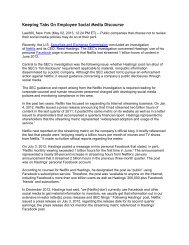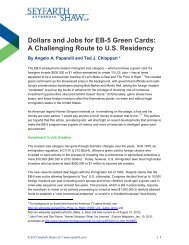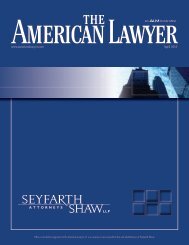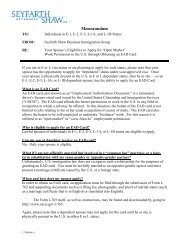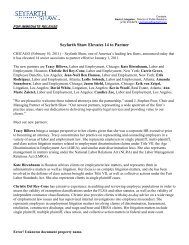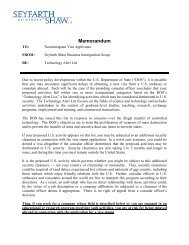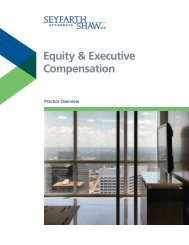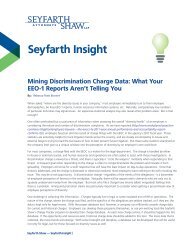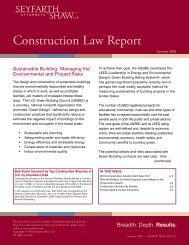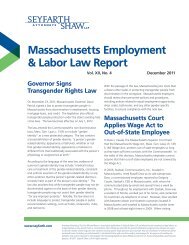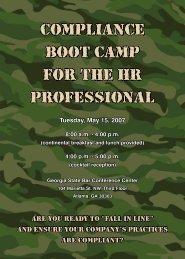Litigating California Wage & Hour and Labor Code Class Actions
Litigating California Wage & Hour and Labor Code Class Actions
Litigating California Wage & Hour and Labor Code Class Actions
You also want an ePaper? Increase the reach of your titles
YUMPU automatically turns print PDFs into web optimized ePapers that Google loves.
Similarly, employers may argue that the “commonality” element is missing, thereby<br />
potentially avoiding the creation of a sub-class. Seyfarth Shaw successfully defeated class<br />
certification in Hughes v. WinCo Foods by advancing such an argument. 373 In WinCo,<br />
plaintiff brought a class action alleging that defendant failed to comply with <strong>California</strong> law<br />
with respect to providing meal <strong>and</strong> rest breaks. Plaintiff asserted that the commonality<br />
requirement was satisfied due to the store-wide policy of requiring employees to obtain<br />
management approval before going on a meal break. The court rejected that argument,<br />
explaining that the decision-making as to when employees took breaks varied from store to<br />
store <strong>and</strong> department to department. The court also concluded that the wide variation<br />
among employees even within each department would require “hundreds or thous<strong>and</strong>s of<br />
‘mini trials.’” 374<br />
D. Opt-In <strong>Class</strong>es<br />
Because of the broad language in Sav-On suggesting that trial courts should be innovative<br />
in fashioning class action procedures, 375 some commentators opined that Sav-On was<br />
approving the trial court’s ability to certify an “opt-in” class action, modeled after the<br />
procedure employed in FLSA <strong>and</strong> Age Discrimination in Employment Act (“ADEA”)<br />
collective actions. In 2005, however, the First District <strong>California</strong> Court of Appeal in<br />
Hypertouch, Inc. v. Superior Court 376 barred trial courts from certifying opt-in classes.<br />
In an “opt-in” class action, employees participate in the action only if they “opt in” by signing<br />
a form. Any judgment obtained in the decision binds only those individuals who opted in.<br />
Although this procedure limits the number of class members bound by a decision,<br />
employers generally like it because it reduces the number of employees offered a recovery,<br />
<strong>and</strong> because those employees who elect not to opt in usually lack interest in the litigation<br />
<strong>and</strong> are unlikely to sue later.<br />
Although opt-in classes were rare in <strong>California</strong>, nothing before Sav-On expressly forbade<br />
them (in contrast to Federal Rule of Civil Procedure 23, which forbids opt-in classes except<br />
where, as in the FLSA <strong>and</strong> ADEA, Congress provides that an opt-in class is the only kind<br />
permitted). 377 In barring opt-in classes under state law, the Hypertouch court reasoned that<br />
<strong>Code</strong> of Civil Procedure Section 382 should be interpreted as parallel to Rule 23, which<br />
373<br />
374<br />
375<br />
376<br />
377<br />
2012 WL 34483 (C.D. Cal., January 4, 2012)<br />
See also Hadjavi v. CVS Pharmacy, Inc., 2011 WL 3240763 (C.D. Cal. Jul 25, 2011) (denying class certification of<br />
overtime, meal <strong>and</strong> rest period claims of nonexempt pharmacy employees <strong>and</strong> holding that the allegation that workload<br />
prohibited breaks was not enough to justify certification).<br />
Sav-On, 34 Cal. 4th at 339.<br />
128 Cal. App. 4th 1527 (2005) (modified without change in judgment, 129 Cal. App. 4th 1348 (2005)).<br />
Id. at 1547-48.<br />
Seyfarth Shaw LLP | www.seyfarth.com <strong>Litigating</strong> <strong>California</strong> <strong>Wage</strong> & <strong>Hour</strong> <strong>Class</strong> <strong>Actions</strong> (12th Edition) 81



